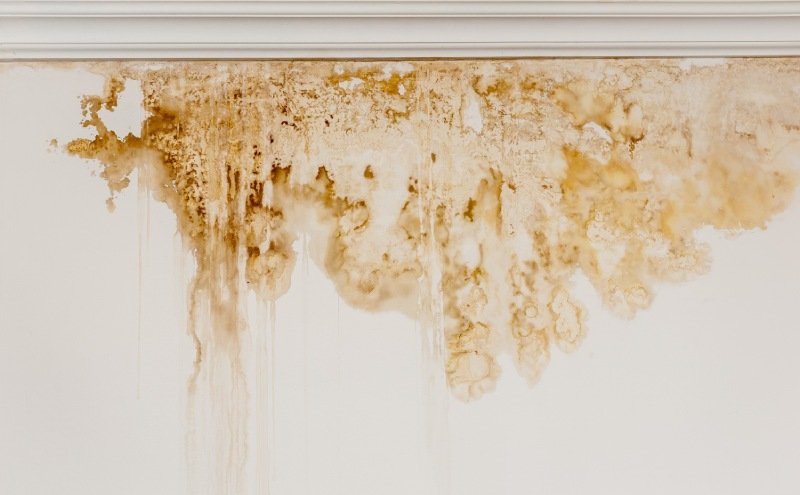No matter the quality of paint you use or how clean you keep your home, all walls are eventually going to get dirty. The accumulation of dust, bumps and scratches from moving furniture – even the dirt and oil from our hands – it all adds up to the point that your walls should be cleaned periodically.

How to properly clean a wall?
How you clean the wall will not only depend on the type of stain, but also on the type of paint that you’re going to be cleaning. If you are unfamiliar with paint chemistry, you might have never heard of different types of paint finishes, how they can affect the cleaning process, and how different types of stains can be met with different cleaning approaches. Let’s quickly go over how a paint’s finish will impact how easy it is to clean, and then check out some general cleaning tips to make your walls look new without damaging the paint.
An important thing to understand is that stains do not come off of all paints equally, and that the finish of a paint is going to determine how easy it is to clean. Simply put, a paint’s finish is how reflective or glossy a paint is. There are five degrees of gloss to choose from depending on the look you want to go for, with high-gloss paint being the most reflective, then moving to semi-gloss, satin, eggshell, and finally matte finish, with matte being the least reflective.
However, in addition to an aesthetic choice, the level of gloss also influences how easy a surface is to clean. The higher the level of gloss, the easier a surface is going to be to clean. For example, high-gloss paint, the most reflective paint finish, is smooth and shiny, with very few crevices and imperfections. Because of this, dirt and grime can be removed very easily from these surfaces.
On the opposite end of the finish spectrum, surfaces painted with matte finish paint are coarse and unreflective, and as a result are much more difficult to clean and remove stains, as the surface is more rough and uneven. This is why certain paints are recommended for different surfaces.
For example, the front door to your home is an area that gets a lot of impact, with people constantly pushing it open and close, which is why high-gloss paint is usually suggested, which would make it the easiest to clean. Likewise, the casings around light switches are almost always painted with high gloss paint, in order to make them easier to clean due to the dirt that accumulates over time with constant use. If there is vinyl or linoleum siding on the outside of your home, there is a good chance it is painted with semi-gloss paint, which is also very easy to clean.
In interior painting, this tends not to be the case, as having the walls inside of your home painted with high-gloss paint would be a very bold design choice, which is why interior walls tend to be painted with lower gloss paints.
The Cleaning Process
Now that you understand the different properties of paint finishes, let’s get to the process of cleaning them. When it comes to higher gloss paints, the process is quite simple. Water will likely do the trick for most areas, and when it comes to your home’s exterior, if you’re dealing with semi-gloss siding, a pressure washer will make quick work of any of the dirt or dust.
But when it comes to your home’s interior, as we mentioned, it is likely that the walls are painted with a satin or eggshell finish, which is a great choice stylistically, but not the easiest to clean. But this does not mean that it is impossible, and there are a few tricks to get your lower gloss walls looking good as new.
For regular cleaning purposes, dishwashing detergent and warm water will be able to clean up most dirt and grime. A small amount of mild detergent will likely be all you need. Simply take a rag, soak it in the solution, wring it out until damp, and apply the solution to the dirty area by lightly scrubbing. Do not add too much pressure as lower gloss paints are less durable higher gloss ones, and can be damaged if you scrub them with too much force. Let the solution sit for two minutes, then dampen a different rag in clean water to rinse off the solution.
For more heavy duty stains, follow the same procedure but with a more powerful cleaning solution. Specialized wall cleaning products are available at any hardware store and are designed for this exact purpose, but if you prefer to use household items, simply add a half cup of baking soda into a quarter cup of water, and mix it together until it is a paste. Gently rub the paste onto the stained area and let it sit for two minutes, then remove it with a clean, damp rag. This should get out stubborn stains on white walls.
Another excellent household item to use is hydrogen peroxide. Take a damp, soapy rag and dab a small amount of hydrogen peroxide onto it and gently press it into the stain and let it sit for five minutes. Remove the solution with a clean, damp rag, and even the toughest stains should disappear. This trick works particularly well on red wine stains!
Cleaning the walls in your home may seem like a daunting task, but by following these simple steps, you can keep your walls looking good as new. Of course, you can always discover other Encore Painting blogs for more painting and housekeeping tips and tricks.